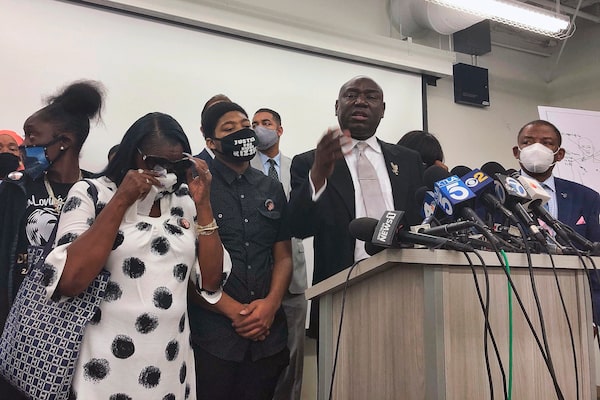
In this Sept. 22, 2020, file photo, attorney Benjamin Crump, at podium, speaks alongside members of Dijon Kizzee's family during a news conference in Los Angeles.Stefanie Dazio/The Associated Press
A Black man shot and killed by Los Angeles County sheriff’s deputies was wounded 16 times in the front and back, according to an autopsy that doesn’t shed any light on whether he was on the ground when he was shot.
Dijon Kizzee, 29, had four “rapidly life-threatening wounds” to the heart, lungs, liver and left kidney, according to the autopsy report that was supplied to The Associated Press on Friday. The autopsy was conducted on Sept. 2.
Three of the shots were to his chest and one to the upper centre of his back, according to the report, which listed the cause of death as multiple gunshot wounds and the manner of death as homicide by law enforcement.
Kizzee also had scrapes to his face, shoulders and other areas, the report said.
The report didn’t indicate the order in which the wounds occurred and noted that the autopsy doesn’t necessarily indicate the position of Kizzee’s body when he was shot.
Attorneys for the family have said witnesses described a volley of shots being fired as he lay on the ground.
Kizzee was killed Aug. 31 in South Los Angeles after sheriff’s deputies tried to stop him for riding a bicycle in the wrong direction. They said they were unaware he had a weapon wrapped in a piece of clothing he was carrying at the time.
Two deputies told investigators they fatally shot Kizzee after he picked up the handgun he had dropped during a struggle with one of them. A video showed him stooping down, but a wall blocked a full view. No weapon could be seen in the video, although authorities found a gun at the scene.
However, attorneys for the family say Kizzee wasn’t holding the gun when he was shot.
Kizzee “posed no threat” to deputies when they fired a total of 19 shots at him, civil rights attorney Benjamin Crump said at a news conference last month.
A message to his office Friday wasn’t immediately returned.
Carl Douglas, another civil rights attorney who is representing Kizzee’s family, said witnesses said the deputies fired three or four shots at Kizzee, followed by a pause and then a second volley while he was on the ground.
Although the official autopsy cited four rapidly life-threatening wounds, Douglas last month said an independent autopsy commissioned by relatives showed that Kizzee did not die instantly and instead writhed on the ground in pain.
The official autopsy found that Kizzee was wounded a total of 16 times. In addition to chest and back wounds, he had other wounds to his hands, arm, chin, shoulder, hip and the back of his head.
Toxicology tests determined that Kizzee had the marijuana compound THC and phencyclidine, sometimes known as PCP, in his blood while some traces of other drugs were found in his urine.
Kizzee’s shooting sparked peaceful protests and followed nationwide protests over police confrontations that killed or injured Black men. George Floyd was killed in May when a Minneapolis officer knelt on his neck, and Jacob Blake was shot in the back and left paralyzed on Aug. 23 in Kenosha, Wisconsin.